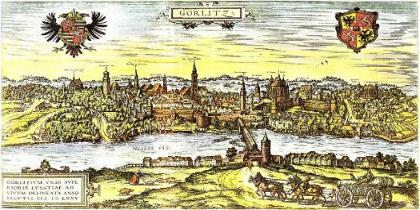

The population of the once prosperous city has fallen by 15 per cent since 1990 as the younger people have left to find work. Before the Second World War, Görlitz was the gateway to the German province of Silesia, which was given away to Poland in 1945. Fortunately, the re-drawing of the border, while slicing the town in half, left the historical town center and the majority of the town’s buildings, which were largely undamaged by war, in Germany. Churchill turned half of it into another “historically Polish city.” German Görlitz in 1575, above
The right bank of Görlitz was taken by the Soviet military on May 8, 1945, and in 1948 the name of that half of the town was changed to “Zgorzelec.” Almost immediately the town was inhabited mostly by four distinct groups of incoming people: Polish ex-soldiers and forced laborers, inmates of a large POW camp set up in Görlitz in 1939, Poles from central Poland and people forcibly moved from the territories taken over by the Soviet Union in eastern Poland. From 1946, the Polish communist authorities began a systematic ‘repatriation’ of all Germans in the town, with the result that there are no more Germans living there today. In 1950, 15,000 communist Greek political refugees settled in the town, but there are only about 200 of them still there today.
Another divided town today is a second German city named Frankfurt: Frankfort on the Oder. It owes its origin and name to a settlement of Franconian merchants in the I3th century.
In late medieval times, the town dominated the trade on the river between the German cities of Breslau and Stettin. In 1430, Frankfurt joined the Hanseatic League, but for only a short time. The Elector of Brandenburg founded a university here and in the 19th century Frankfurt played an important role in trade. Its central position, heavily-trafficked river and large annual trade fair was surpassed only by that in Leipzig. Frankfurt decayed under Communist occupation, its bomb damage unrepaired and its downtown uglified. Its ancient Marienkirche had been destroyed and never fully rebuilt, its destroyed red brick tower rebuilt in white concrete, and all the stained glass windows removed and shipped to museums in Moscow. Once located on both sides of the Oder River, it was cut in two and its other half is in Poland and goes by the name of Słubice.
Guben developed around 1200 as a marketplace on the roads between between Leipzig, Görlitz and Frankfurt (Oder). Guben received the municipal law by the Wettin Mark count Heinrich III of Meissen in 1235. A cloister of Benedictine nuns began developing on the western shore of the river. Until 1815, Guben belonged to the Margravate of Lower Lusatia (which between 1367 and 1635 belonged to Bohemia) without interuption. In 1635, Elector Johann Georg I of Saxony received Lower Lusatia and Guben in the Peace of Prague. In 1815, the Margravate of Lower Lusatia was replaced with the district system and Guben became the capital of a district within the Province of Brandenburg. Guben’s textile industry began to develop in the 16th century, and it became a center of hatmaking. Guben became a rail connection between Frankfurt/Oder and Breslau in 1846 and between Cottbus and Crossen an der Oder in 1871.
At the end of World War II in 1945, Guben was 90% destroyed by Allied Bombing and because Guben was on the Lusatian Neisse, the city was separated into German Guben and Polish Gubin. The German residents of the Polish part of Guben were forcibly “evacuated” in 1945. Because the historical center of Guben became Gubin, the western suburbs which grew from the cloister remained in Guben.
Cottbus was established in the 10th century, when Sorbs erected a castle on a sandy island in the Spree river. From the 13th century when German settlers came to the town, they have lived together with the Sorbs. In medieval times Cottbus was known for wool and fabric manufacturing. On February 15, 1945, the lovely old town of Cottbus was bombed by 4,000 high-explosive American bombs, destroying 356 houses and damaging 3,600. 1,000 people dead, among them 400 children, and 13,000 were left homeless. Parts of its hospital were destroyed, its doctors and nurses killed. It was handed over to the communists where it could languish for decades. It is now part of Germany.
Medieval Plauen, on the Elster river, won its city charter in the early 13th century. St. Johann’s Church was dedicated in 1122 and the Rathaus built in 1508. There was once a rich cotton dealer, Baumgärtel, whose stuccoed festive hall dated from 1786. A Schleierherren (veil man) of Plauen, he sold woven fashion merchandise in the 18th century. Plauen lace became famous throughout the world after 1880. The Lutheran church at the northern edge of the old city had existed since 1722, and was the oldest significant Baroque building left in Saxony. Its four-winged altar, which was in the St. Thomas Church of Leipzig until 1722, was created around 1500 near Erfurt.
5,700 tons of weapons were dropped by British and American bombers on Plauen, destroying 75% of the city and killing 2,443 people in 14 air raids. In the bombing, the citizens had ingeniously fortified old rock cellar areas under a former factory. The underground halls held 7,000 to 8,000 persons and it had its own water and electric supply.
However, in these closed cellars crowded with people, the air supply became dangerous during 2-3 hour air raids. Ancient St Johann’s Church was all but totally destroyed. From April 16 to June 30, 1945, the American army occupied Plauen and the Vogtland, containing the people before handing them over to the communists on July 1. The ancient city entrances were later blown up by occupying Soviet troops.